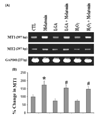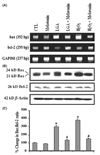Cytoprotective effects of melatonin on C6 astroglial cells exposed to glutamate excitotoxicity and oxidative stress
- PMID: 18373557
- PMCID: PMC2632944
- DOI: 10.1111/j.1600-079X.2008.00582.x
Cytoprotective effects of melatonin on C6 astroglial cells exposed to glutamate excitotoxicity and oxidative stress
Abstract
To preserve the central nervous system (CNS) function after a traumatic injury, therapeutic agents must be administered to protect neurons as well as glial cells. Cell death in CNS injuries and diseases are attributed to many factors including glutamate toxicity and oxidative stress. We examined whether melatonin, a potent anti-oxidant and free radical scavenger, would attenuate apoptotic death of rat C6 astroglial cells under glutamate excitotoxicity and oxidative stress. Exposure of C6 cells to 500 microM L-glutamic acid (LGA) and 100 microm hydrogen peroxide (H(2)O(2)) for 24 hr caused significant increases in apoptosis. Apoptosis was evaluated by Wright staining and ApopTag assay. Melatonin receptor 1 appeared to be involved in the protection of these cells from excitotoxic and oxidative damage. Cells undergoing excitotoxic and oxidative stress for 15 min were then treated with 150 nM melatonin, which prevented Ca(2+)influx and cell death. Western blot analyses showed alterations in Bax and Bcl-2 expression resulting in increased Bax:Bcl-2 ratio during apoptosis. Western blot analyses also showed increases in calpain and caspase-3 activities, which cleaved 270 kD alpha-spectrin at specific sites to generate 145 kD spectrin breakdown product (SBDP) and 120 kD SBDP, respectively. However, 15-min post-treatment of C6 cells with melatonin dramatically reduced Bax:Bcl-2 ratio and proteolytic activities, decreasing LGA or H(2)O(2)-induced apoptosis. Our data showed that melatonin prevented proteolysis and apoptosis in C6 astroglial cells. The results suggest that melatonin may be an effective cytoprotective agent against glutamate excitotoxicity and oxidative stress in CNS injuries and diseases.
Figures





References
-
- Tan DX, Manchester LC, Terron MP, et al. One molecule, many derivatives: a never-ending interaction of melatonin with reactive oxygen and nitrogen species? J Pineal Res. 2007;42:28–42. - PubMed
-
- M Hardeland R, Backhaus C, Fadavi A. Reactions of the NO redox forms NO+, *NO and HNO (protonated NO−) with the melatonin metabolite N1-acetyl-5-methoxykynuramine. J Pineal Res. 2007;43:382–388. - PubMed
-
- Mesenge C, Margaill I, Verrecchia C, et al. Protective effect of melatonin in a model of traumatic brain injury in mice. J Pineal Res. 1998;25:41–46. - PubMed
-
- León J, Acuña-Castroviejo D, Escames G, et al. Melatonin mitigates mitochondrial malfunction. J Pineal Res. 2005;38:1–9. - PubMed
-
- Jou MJ, Peng TI, Yu PZ, et al. Melatonin protects against common deletion of mitochondrial DNA-augmented mitochondrial oxidative stress and apoptosis. J Pineal Res. 2007;43:389–403. - PubMed
Publication types
MeSH terms
Substances
Grants and funding
LinkOut - more resources
Full Text Sources
Research Materials
Miscellaneous

